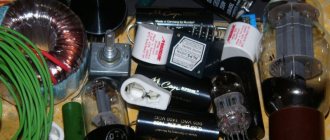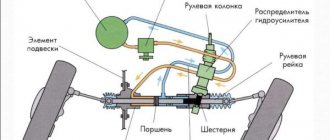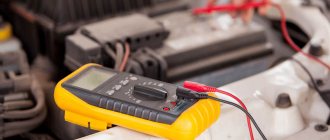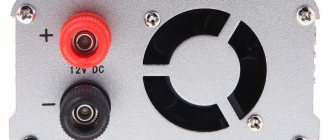Assembling a good car audio system is not an easy task even for people with extensive experience in this field. Not only do you need to select all the elements of the set so that they work together correctly, but you also need to connect them correctly and fine-tune them. One of the most important components that you need to buy is a car amplifier, this will be responsible for sending a strong enough signal to the speakers.
The choice of car amplifiers on the market is very large, their power varies from a few watts per channel to a thousand. In this article, we will tell you which amplifier to put in your car and list the top 10 car amplifiers so that you can find the perfect product among them.
Amplifier device
A power amplifier is one of the main elements of any sound system. It receives a signal from the linear output of the car radio, amplifies its voltage and power to a certain value required for optimal operation of the speaker systems.
There are several classes of acoustic power amplifiers. Belonging to a certain class depends on the technical characteristics of the device, its power and the level of signal distortion at the output.
Power amplifiers for car audio
In serious car audio installations, a separate external amplifier is found. Let's figure out what kind of car power amplifiers there are, what their advantages are and get rid of some misconceptions.
On the radio you can see the numbers “4 x 50W” - this is the maximum power that they produce at the peak of the signal (for a short time). At the same time, nonlinear distortions reach 10% - this is no longer music. The speakers will easily play back two dozen watts given by the built-in amplifier of the radio. But exactly 10–20 W, not 50! The rated power of head units varies within these limits. This is the power at which the music does not wheeze or squeak.
Types of subwoofer amplifiers and speakers
Car two-channel amplifiers.
Use a pair of speakers or one subwoofer for high-quality and powerful sound. Why one? The subwoofer must reproduce low frequencies (below 60-100 Hz), but they are not localized. Therefore, you can get by with one subwoofer connected simultaneously to two channels in mono mode (bridged connection). With a bridge connection, the power output from the amplifier will be much higher. For example. If a two-channel subwoofer has a rated power of 2x60 W, then when connected in bridge mode it is capable of delivering 1x200 W. To ensure that the sub plays only low frequencies, use a low-pass filter built into the amplifier. Without it, the music will turn into “bubbling” from the trunk. With the rest of the acoustics they do the opposite - they remove the low ones. Are there single channel amplifiers? This is a one-piece product and is not widely used due to its specifics. They are found in professional audio systems when the maximum power of the subwoofer is important, not its sound.
The most common are four-channel amplifiers - they have earned popularity due to their versatility. The most common connection scheme is two channels for the front speakers and two channels for the subwoofer. So we simultaneously connect the speakers and the subwoofer, and if there is none, we connect the rear speakers. There is also a “per-channel” connection - one pair of outputs goes to the tweeters, the second to the speakers.
- Building a music system in a car for dummies
There are three-channel devices.
The third channel is used to connect a subwoofer. Impossible to find on sale, because... they were supplanted by four-channel “amplifiers” due to their versatility. The same goes for six-channel devices. Five-channel amplifiers are essentially four-channel amplifiers with an additional subwoofer channel. If everything is clear with the “bass” channel, then the remaining four can be used for a system with front and rear speakers or “channel-by-channel”.
Buying a sound amplifier is half the battle, the other half is installing it. The housing and wiring must be securely fixed. Don’t forget about natural ventilation - all the “amps” heat up. And lastly: if the on-board system survives one amplifier without loss, then in the case of several powerful ones, difficulties are possible.
Amplifier classification
- Class A
amplifiers have low efficiency, but nevertheless produce a very “good” signal. Many of them have a low efficiency of 20–25%, which means that, consuming 100 W from the on-board network, it produces a signal of about 20–25 W to the speaker systems. The remaining power is dissipated in the amplifier circuit, transforming into heat. Representatives of class A are practically not used in automotive systems due to their low power and disproportionately high price; - Class B:
Amplifiers of this class are much more efficient, but they are also not without certain disadvantages; they have too much distortion of the output signal. For this reason, they are not used in car audio systems; - Class AB
- The most common and popular today. Devices of this type combine the advantages of both classes, namely good efficiency and signal purity; - class C
amplifiers , with a relatively high efficiency, there is a strong distortion of the output signal. Therefore, their use in automotive systems is considered inappropriate; - Class D:
Is the most modern. These amplifiers digitally process the signal. They are small in size and weight. Currently they are used quite rarely due to their high cost.
{banner_content}
Types of devices
It is necessary to correctly select an amplifier in a car based on the parameters based on the advice of experts. First you need to pay attention to the number of channels. Some models have 6 units at once. Quite popular are 1-channel models, which are often used in vehicles for subwoofers. Another important parameter is the internal crossover, which is currently included in the design of almost all power amplifiers. When selecting an amplifier for the acoustics in a car, this element is important in order to cut off frequencies. The most modern models include smooth adjustment of this indicator.
Which car amplifier to buy
You need to understand that the choice of amplifier depends on what kind of acoustics you have installed in your car. If you are just going to get it, then everything is much simpler - in the future you will be guided by the capabilities of your amplifier.
So, which models are worth paying attention to:
1. Pioneer GM-D8601 and Pioneer GM-D9601 are the simplest single-channel models. They are used to connect one or more subwoofers to them.
2. You should look towards the two-channel model Mystery MR-2.75 if you have an audio pair - two speakers. However, you can connect a subwoofer to this amplifier instead (bridge connection is used).
3. Pioneer GM-A5702 is also two-channel, and therefore the advice for purchasing it is the same.
4. The purchase of Kicx RTS 4.100 or Sony XM-S400D should be considered by audiophiles who have many speakers and subwoofers in their car. Although in fact these are universal models, because no one bothers to output two channels to the speaker at once, allocating the same amount to the subwoofer.
Friends will also be interested in this
Do you want to receive up-to-date ratings and selection tips? Subscribe to our Telegram.
Choosing an amplifier for the car - a guide for beginners
Why is it so important to buy a car amplifier? This question is asked by people who believe in power numbers on radios like 4x50W. And the maximum power of the radio 4x50 W and the rated power of the additional amplifier 4x50 W are not the same thing at all. By the way, some modern radio tape recorders already indicate the real rated power of 4x18 W. In addition, a multi-function head unit with a compact, low-power amplifier cannot match the sound quality of a dedicated large power amplifier. Comparing the sound quality of an external amplifier with the one built into the radio, we can say that the latter has a narrower dynamic range and less deep bass.
The fact is that when an external amplifier is connected, the built-in amplifier is not used; the sound is taken from the preamplifier, bypassing the low-quality, “flat” playing built-in amplifier. Some car radios even have a function to turn off the built-in amplifier. The sound of a tape amplifier is considered “flat”. Because the tops of the sine of the sound signal (music) become really flat when the volume control of the radio is turned up to maximum. The process when the signal exceeds the maximum permissible level and its tops are cut off is called clipping.
This problem manifests itself not only in the deterioration of sound. At the same time, the speakers heat up more. An overheated voice coil can fail. This will lead to the purchase of a new set of speakers, which may suffer the same fate if measures are not taken. In this case, the solution to the problem would be to purchase an external power amplifier. You can, of course, not raise the volume level of the radio to the point of audible distortion. The only thing is that even at a volume level of more than 50%, the amplifier built into the radio already has a fairly high coefficient of harmonic distortion, which spoils the sound quality.
A car radio that has a built-in radio tuner (and sometimes a TV tuner), a CD or DVD drive, a USB player, a digital-to-analog converter and even an audio signal processor (DSP) in one small case cannot also accommodate a high-quality power amplifier. So it is advisable to “unload” the head unit using a separate amplifier.
Choosing the right solution
So, you have a car radio and several speakers in the car. Question: Which amplifier is suitable for your audio system? First of all, you need to know how many line outputs your radio has. If there is none, then to connect an external amplifier you will need a special adapter that takes a high-voltage acoustic signal from the radio and converts it into a low-voltage one. Some amplifiers have a similar built-in Hi-Level converter. Most budget car radios have one pair of line outputs for connecting through an external rear speaker amplifier or subwoofer. And more advanced head units have two or three pairs of linear outputs. Using Y-splitters (like Mystery MRCA YM) you can make two or three pairs of outputs from one pair, but without the ability to separately adjust the volume level of the subwoofer, rear and front.
An amplifier with how many channels is needed?
| Pioneer GM-A5602 - 2-channel power amplifier with bridged capability |
Now let’s figure out how many amplification channels are needed in a given situation. If the magnetic amplifier has four output channels, then additional amplifiers have from one to six channels. If you want to regulate all channels independently of each other from the head unit, then the amplifier is selected based on the number of linear outputs of your radio. That is, for a radio with 4 linear outputs, one 4-channel or two 2-channel will fit. But in practice, you usually only need to adjust the subwoofer volume level. And independent adjustment between the front and rear speakers is necessary only if the radio is equipped with a DSP processor.
A single-channel (monoblock) like the Kicx KAP 10M is used to connect to a regular mono subwoofer. In car audio, stereo subwoofers are not used, and several low-frequency speakers are installed only to increase sound pressure.
When using a 2-channel speaker (for example, Blaupunkt GTA-270) in stereo mode for two front or two rear speakers, no questions arise. But when using a 2-channel speaker in mono mode with a bridge connection circuit, there is a small drawback - the clarity of low frequencies is lost, especially when playing music with fast bass. Less booming and richer low frequencies can be obtained using a monoblock. And since it costs more than a 2-channel amplifier, in budget audio systems 2-channels bridged to a subwoofer are more common.
For 4-channel amplifiers like the Helix Xmax 4.2, there are several connection options. The most common are the classic mode for four speakers (front and rear) and the 3-channel amplifier mode for two front speakers and one subwoofer (where 34 channels are included in a bridge circuit). A less common option for enabling 4-channel is 2-channel mode (two bridged connections). This mode is used, for example, when connecting two subwoofers or two powerful midbass.
The rarest option for using 4-channel amplifiers is called bi-amping, where 12 channels are connected to tweeters, and 34 channels are connected to door midbass. This option gives the best sound from the audio system (sometimes called Hi-Fi mode). Why is it the least used? Firstly, due to the ignorance of not only buyers, but also some sellers in the car audio industry. Secondly, the 4-channel is intended only for front component acoustics and this solution is a little more expensive. The main thing in a channel-by-channel connection is the presence of LPHP filters capable of operating at frequencies from 2 to 6 kHz. For example, such per-channel filters should be either in a radio tape recorder or in a 4-channel amplifier, which is very rare. If you are going to use a 4-channel only in a stereo front + one subwoofer system, then it is better to take a 3-channel amplifier , for example JBL GTO-3EZ. Although, if you consider that over time we usually change cars and audio systems in them, then the 4-channel is more universal.
| Example of an amplifier with LPHP filters - DLS MRA41 |
6-channels are now rarely found on sale. a 5-channel amplifier with a similar purpose (for example, the Blaupunkt GTA-5350 is one of them). This type of multi-channel amplifier is usually used for two front components and two rear ovals plus one subwoofer. Amplification of five channels is immediately cheaper, but one power supply designed to work on five channels simultaneously will, in reality, primarily serve the low-frequency channel that requires the most energy. 12 channels and 34 channels can operate in a bridged connection, but 5-channel speakers are never used for three subwoofers. In channel mode, these amplifiers can be used, for example, with an Alpine CDE-195BT head unit equipped with channel filters, but it is not wise to use the amplifier to improve the sound quality of front components, where the fifth subwoofer channel will spoil the sound.
| Panel with connectors for 5-channel amplifier Alpine PDX-V9 |
From everything written above, it follows that we choose an additional power amplifier based on the number of linear outputs on the radio , remembering that the use of Y-channel splitters solves the problem of an insufficient number of linear outputs, but to the detriment of sound quality and channel regulation. The amplifier is also selected based on the pre-designed composition of the audio system, that is, the number of speakers in the car.
This is not as simple as it seems - many people count channels incorrectly. For example, two high-frequency tweeters in the dashboard or door corners and two midbass at the bottom of the front door panels are not four channels, but two component ones. Rear speakers in the stock configuration sometimes consist of four channels, but this is if two channels are in the rear doors, and two in the rear parcel shelf or in the rear compartment (the parcel shelf behind the rear seat). As a rule, there are only two channels in the rear of the cabin. We also consider component rear speakers as two channels, similar to front component ones. That is, a classic audio system is 4+1 (stereo front + subwoofer). But a 2 + 1 audio system (stereo front + subwoofer) is considered to be of higher quality in sound.
You may be wondering why 3 channels are better than 5? The fact is that the rear speakers in an audio system with a subwoofer link are used only for passengers in the rear seat. By taking care of them, we spoil the sound in the driver's seat area. In stereo front + subwoofer audio systems, using a DSP processor, the sound is phased only at one point in the car. And if you add rear speakers to such a tuned system, the sound will be less clear. Imagine several dancers on stage performing the same movements in harmony - their dance will be beautiful. And if you take someone from the audience onto the stage and ask them to repeat the movements of the artists, this will spoil the overall picture.
Therefore, it is better to determine in advance what kind of audio system you want for yourself in order to correctly select an amplifier .
In a planned or existing front-rear + subwoofer audio system, the most budgetary additional amplifier will be a 2-channel one, only for the subwoofer.
The next price category includes two options for equipping the audio system with an amplifier. The option of adding another 2-channel amplifier for the front or rear speakers to a 2-channel subwoofer amplifier is not correct, because then the amplified channels must be adjusted in level to the non-amplified clipped (distorted) two channels from the radio. Similar in price, but more accurate would be 5-channel dubbing of all channels. If the subwoofer is already equipped with an amplifier, then you should strengthen the front and rear speakers with a 4-channel speaker.
The planned front + subwoofer audio system (without rear speakers) will also fit amplifiers of different configurations:
1) one 2-channel or monoblock for a subwoofer, where the front speakers are connected to a magnetic amplifier;
2) two 2-channel or one four-channel, where all channels are amplified;
3) one 5-channel or 4-channel + monoblock for channel Hi-Fi mode: 12 channels for tweeters, 34 for midbass and a fifth channel or one monoblock for a subwoofer.
How to choose an amplifier in a car (video)
Of course, these are not all the indicators that you should pay attention to when choosing an amplifier, but they are the main ones. By following the recommendations outlined in the article, you can choose a decent amplifier for your audio system. We really hope that we have answered your question about how to choose an amplifier for speakers or a subwoofer, but if you still have unclear points or wishes, we will be happy to answer this in the comments below!
If you want to get maximum pleasure from music in your car, you will have to spend a lot of money. First, you will need a relatively good car radio. Secondly, you need to stock up on acoustics, which would include not only speakers, but also a subwoofer. And thirdly, and most importantly, if you have a large number of speakers, you will need a car amplifier. As its name suggests, it significantly amplifies the signal so that it is powerful enough to output at the highest volumes. As they say, it is impossible to win car audio competitions without an amplifier. Moreover, it must be of high quality. You will read about the best amplifiers for the car below.









